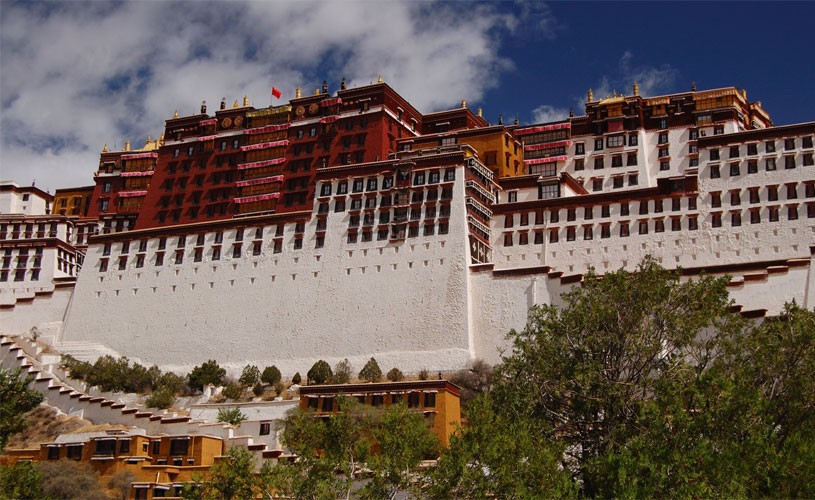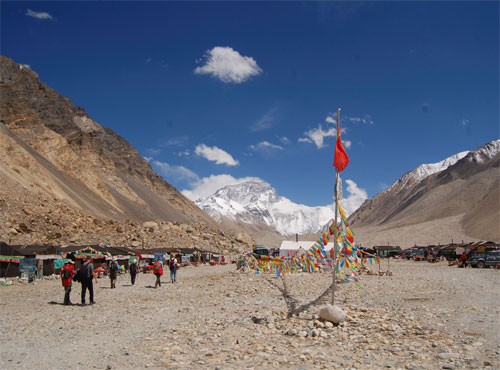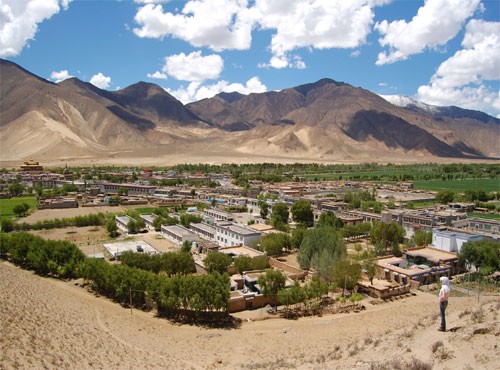Lhasa to Everest Base Camp Tour - Explore EBC Via Lhasa
The Lhasa To Everest Base Camp Tour captures Tibet's spiritual, historical, and natural essence. It leaves us with an unforgettable feeling of fulfillment and a treasure chest of memories.
Lhasa-Everest Base Camp Tour will take you from Lhasa (a modern, spiritual city) to Everest Base Camp – the base of the highest peak in the world. This road trip takes you from Lhasa, a bustling metropolis, to ancient monasteries and beautiful lakes. The tour will also take you to several breathtaking mountain passes, rivers, and frozen glaciers. You'll see Tibetan valleys as well as the North Everest Base Camp. This Lhasa overland tour is an excellent way to experience the majestic Mt. Everest, which is one of the most impressive achievements you have made.
The Lhasa-EBC tour begins and ends in Lhasa – the epicenter of Tibetan Buddhism. This tour takes you to three historic cities in Tibet, including Lhasa Gyantse and Shigatse. This 8-day Lhasa Base Camp Tour will take you from Lhasa up to Everest Base Camp. This is a classic trip that will appeal to any traveler.
Discover the old Barkhor Street market and Potala, the Dalai Lama's winter palace. The Jokhang Temple was founded in the 7th Century by the 33rd king of Tibet. Two-day tours in Lhasa offer a look at Tibetan culture and history. You'll also get to see the breathtaking highland Tibetan Plateau. Although modern, the people of the city still follow traditional culture.
This trip includes a visit to Drepung Monastery, located at the base of Mt. Gephel, a major university monastery in Tibet that practices Gelugpa Buddhism. Sera Monastery is located at the foot of Tatipu Hill, north of Lhasa. Sera Monastery's courtyard is an excellent place to observe the monks debating. They hold debates as part of their study to better understand Buddhism. Shigatse is a short drive away. Shigatse is the second largest town in Tibet. Along the Friendship Highway, you'll pass the holy Yamdrok Lake. This is one of Tibet's three sacred lakes. After a long drive on the highway, you reach Gyantse. The beautiful Gyantse Kumbum, Pelkor Chode Monastery, and Tashi Lhunpo Monastery are all in Shigatse. Another architectural marvel of Tibet. It is also home to the Panchen Lama. Future Buddha, the dramatic statue of Maitreya Buddha, is also called Future Buddha.
Rongbuk Monastery lies at a height of 5,000m/16,4000ft. You will pass through several high passes on your way to Mt. You'll have to pass several high passes on your way up Mt. Enjoy the breathtaking scenery on Mt. You'll also enjoy the stunning scenery of Mt. Cho Oyu (8.188m/26.906ft) and Mt. Shishapangma (8.27m/26.289ft) from Geu La Pass.
Rongbuk, the world's highest Tibetan Buddhist monastic monastery, is located near Everest's base camp. In Tibet, the gateway to Mt. Everest is called Chomolungma, Chomolungma, and Chomolungma. The perfect spot to watch the sunrise or sunset over Mt. There is also a beautiful round chorten in the monastery and statues of Shakyamuni. Also, there are beautiful round chortens with statues of Shakyamuni. Old mural paintings depict Tibetan cultures and religions.
After a lovely time at Rongbuk Monastery, you will travel early the next day to Everest Base Camp. Another highlight of the trip is this stop. This North Everest Base Camp is known for its beauty and mountains. After exploring the base camp, you will drive back to Shigatse via the Friendship Highway. Then, you'll return to Lhasa by way of Yalong Valley. Enjoy the Tibetan plateau scenery. Then, you will continue to your next destination. The eight-day Lhasa Base Camp Tour will end when you reach your final destination.
When is the Best Time for the Lhasa -Everest Base Camp Tour
The best time to visit Everest Base Camp via Lhasa is April to Jun and September to November. This is the best time to visit because it's warm and sunny, with little to no rain. The tour can be done in Winter, such as December, January, and February. However, it will be freezing. Temperatures drop to minus 15 degrees Celsius.
Food During Kathmandu To Lhasa Overland Tour Via EBC
On this trip, only breakfasts are provided. You'll need to pay for your lunches and dinners. Breakfast will be served where we stay overnight, and dinner arrangements can be similar. Lunch will be eaten while we're traveling to the next place. We suggest budgeting around Yuan 60 to Yuan 100 (US$10 to US$16) per day for lunch and dinner. Our meals will include Tibetan bread, dal (lentil soup), bhat (rice), tsampa porridge, and other basic local dishes.
Visa, And Paperwork Process For Tibet Overland Tour
It would help if you had a Chinese Visa and a Tibet Travel Permit to travel to Tibet. You can get both of them from Kathmandu, with the help of a travel agent. You must obtain a Tibet Travel Permit even with a Chinese Tourist Visa. A permit is required for those who travel from mainland China into Tibet. You must book a guide for your whole trip and pre-arrange private transport for trips outside Lhasa. You also have to get additional permits for a trip outside Lhasa. These permits are arranged by the company you are traveling with.
Important Notice For Tibet Overland Tour From Nepal
According to the new rules from the Chinese Embassy in Nepal, at least 05 people are needed to receive a Tibet visa. The original passport is also required for the visa application in Kathmandu. The process may take up to 05 working days. Clients who wish to apply for a Tibet Group Visa must also visit the China Visa Application Center in person and provide their biometric data.
Please note that regulations and requirements for visas can also change often. We also want to point out that visa regulations and requirements for Tibet can change frequently. Please check with Dream Tibet Travel before booking your Tibet tour.
Safety Guidelines
We recommend you go through our safety guidelines and stay tuned with the latest happenings.
- Have at least two copies of the Tibet Permit.
- Keep your belongings properly.
- When you feel uncomfortable due to altitude change or troubles, report to train staff promptly.
- Take your time visiting attractions shortly after you arrive in Lhasa.
- Shop around but avoid undue bargaining with street vendors and never buy wildlife and unknown Tibetan herbal medicine and fake products.
- Take your money and essential belongings with you all the time.
- Spend a few days in Lhasa for acclimation and consistently follow a gradual ascent when traveling to higher places to avoid altitude sickness.
- Refrain from heavy drinking and smoking.
- Respect the religion and customs and avoid taboos in Tibet.
- Pay special attention to the unique alpine climates (such as sunburn, dramatic temperature change, etc.)
- Keep the necessary medicines at your doctor's consultation.
- Travel alone at night or venture into unknown places without informing your guide.
- In most places, cash is only accepted. Do prepare enough and minor changes.
- If an emergency arises, report it to your guide promptly.
- Don't carry any documents or papers related to the Dalai Lama or feel Tibet.
- We also recommend not carrying any guidebook to Tibet.
Packing list for Everest Base Camp Tour
- Down jacket
- Thermal underwear,
- Warm headwear
- Sunscreen
- Sun hats
- Toiletries,
- Personal medicines
- Mountain sickness,
- Cold relief, or diarrhea






